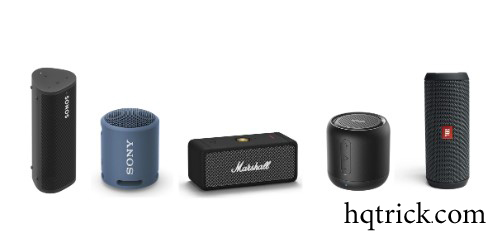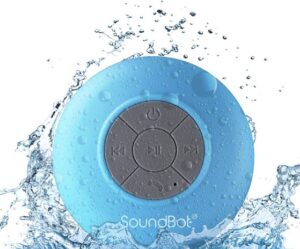Bluetooth speakers are portable speakers that allow you to wirelessly connect and stream music, podcasts, or other audio content from your smartphone, tablet, or other Bluetooth-enabled devices. They are popular for their convenience and versatility, making it easy to bring your favorite music or audio wherever you go.
It is important to note that the term “Bluetooth speaker” does not necessarily refer to a specific size or shape. Bluetooth speakers come in various sizes, from compact and portable models to larger stationary models.
Portable Bluetooth speakers usually have a built-in battery, which allows them to be used on the go without the need for a power source. Whether you are at home, out for a picnic, or at work, these portable speakers are often small and handy, making it easy to carry in your pocket.
It’s important to consider your specific needs and preferences when choosing the right Bluetooth speaker for you, whether you prioritize portability, battery life, additional features, or audio performance. When you buy a Bluetooth speaker, be sure to carefully evaluate your options.

How to connect a wireless speakers: Bluetooth or Wi-Fi?
Mobile devices, such as your smartphone or tablet, can connect to wireless speakers using two methods:
- Bluetooth which is the most common method used by wireless audio speakers
- Wi-Fi is another way to connect that is available in more expensive speakers
In the following, we will highlight the differences, advantages, and disadvantages of both types of connections.
Bluetooth:
- Bluetooth connection occurs by pairing the speaker with a compatible device such as a smartphone or tablet.
- Easy to connect without the need for network support, allowing mobile use anywhere.
- Limited bandwidth may result in slightly compressed audio files, but the difference in quality is usually not noticeable to normal listening.
Wi-Fi:
- Multiple Wi-Fi speakers can be paired together, allowing simultaneous audio playback in multiple rooms.
- Allows the creation of multi-channel setups, such as stereo or surround sound systems.
- Provides uncompressed audio transmission for better sound quality.
- Requires a router and an existing internet connection to run.

In addition to the main Bluetooth connection, a Bluetooth speaker usually provides other connection options, including:
- AUX-in: This allows you to input an audio source using the 3.5mm jack, primarily for devices that cannot connect wirelessly, such as portable CD players, laptops, or desktop computers. This option conserves battery life on your mobile device when Bluetooth is not needed.
- Ethernet (LAN): Some wireless speakers allow you to connect to a network over a LAN, which provides higher bandwidth and doesn’t interfere with other WLAN devices. This can be useful for transmitting video and audio, especially in home entertainment systems.
- Wi-Fi Direct: With Wi-Fi Direct, you can establish a Wi-Fi connection between your music player and soundbar without the need for a Wi-Fi router or Internet connection, similar to Bluetooth pairing but with WLAN.
- Chromecast: Some models have Chromecast built-in to stream music from Android devices. Chromecast provides better sound quality than Bluetooth because it does not compress data.
- Integrated Streaming Service: If your wireless speaker supports streaming services like Spotify, it can connect directly to the appropriate server via Wi-Fi, allowing your mobile device to act as a remote control for playing music. This results in better sound quality compared to Bluetooth, where Wi-Fi streaming is less compressed.
Note: Almost every Bluetooth speaker model, regardless of size or price, usually includes an AUX-in connector, while integrated Ethernet, Wi-Fi Direct, Chromecast, and streaming service options may vary depending on the speaker model and its brand.
What additional features should I watch out for?
Depending on your personal needs, there are a few features to consider when looking for a Bluetooth speaker.
Many modern portable speakers offer the following additional features:
Integrated System: Some models allow for splitting of the audio output to multiple speakers or stereo separation, where more than one wireless speaker can be combined to form a stereo system wirelessly via Bluetooth. However, it should be noted that mixing different models or brands together may not always be easy. It is recommended to use an additional device from the same manufacturer and model series if you plan to create a multi-speaker system setup.
Call Functionality: Most Bluetooth speakers on the market have a built-in microphone, allowing you to take calls from your smartphone and make hands-free calls. This handy feature also enables conference calls. If you receive a call during a music session, the speakerphone will pause and resume playback automatically once the call ends.

Dust and Splash Resistance: This feature can be very useful during use if you plan to take your wireless speaker to places like a park, beach, or pool. Many models use an IP rating to indicate dust and water resistance, displayed as IPXX (the first X indicates dust resistance, the second indicates protection against water). A higher number indicates higher resistance. If a speaker has an X instead of a number, it means that it does not have a rating in that category (for example, IPX7 indicates that it does not have a dust resistance rating).
How long is the battery in the speaker?
The battery life of a wireless speakers varies by model. As a rough guideline, most devices last between 10 and 15 hours. However, some powerful models can last an entire day.
It’s important to note that volume directly affects battery life. The higher the volume, the faster the battery will drain.
You should also consider the manufacturer’s information on the subject, keeping in mind that the maximum volume may not always reflect the actual runtime. The impact of volume on battery life varies from device to device, but in general, you don’t have to worry about a battery lasting only half as long as specified by the manufacturer at high volume, for example.
Which Bluetooth speakers has the best sound quality?
When it comes to cheaper, portable Bluetooth speakers, you have two options: listen to a sample or opt for well-known brands like JBL, Anker, and Sonos.
Brand manufacturers usually guarantee good sound quality, although personal preferences for sound can vary. In this regard, models that have an appropriate equalizer application and allow you to adjust the sound profile to your liking are recommended.
For larger wired hi-fi speakers, you can generally expect rich sound quality. However, it’s still important to listen to them and test them at home to account for the idiosyncrasies and specializations of each manufacturer that may affect the sound.
Which Bluetooth speaker is the loudest?
There are two factors to consider for loudness.
First, you can check the decibel number of the speakers you want to buy. If it is equal to or greater than 95dB, it will be loud enough to make the music audible even in a group of people talking.
Second, it’s important to note that small portable speakers have a natural limitation in terms of volume, while high-quality, wired Bluetooth speakers (usually used at home) can provide a much higher volume level at the same decibel number, potentially surpassing the sound output of smaller speakers.
What about smart speakers like Amazon Echo, Google Home, etc.?
Smart speakers like Amazon’s Echo and Google Home share similarities with wireless speaker systems in that they can stream music from external devices via Bluetooth, Wi-Fi, or other systems like Apple’s Airplay.
In addition, smart speakers can be integrated into a stereo or multi-room system, and they also have the ability to answer hands-free calls.
In terms of sound quality, Alexa, Google Home, and similar smart speakers can deliver an amazing performance. However, there are notable differences. Unlike portable Bluetooth speakers, smart speakers require a power outlet and are not inherently portable. Although it is possible to make them portable with a power bank or battery pack, this is not the intended use according to Amazon. Additionally, smart speakers lack protection from dust and water, making them essentially indoor devices. However, Amazon has announced a portable Bluetooth speaker called Echo Input Portable, which is currently only available in India and may take some time to be available elsewhere.
One of the main advantages of smart speakers is their internet connectivity, allowing users to stream music online without relying on a Bluetooth-enabled device such as a smartphone. Users can also select songs, artists, and albums through voice commands, such as “Hey Alexa, play something from…”. However, the availability of services depends on the smart speaker, as Amazon has been integrating Amazon Music and Spotify support since June 2018.
Conclusion : When considering buying a Bluetooth speaker, there are several factors to keep in mind:
- Sound Quality: The sound quality of the speaker is crucial, as it determines the overall listening experience. Look for a speaker that delivers clear and balanced audio with good bass and treble performance.
- Portability: If you plan to use the speaker on-the-go or in outdoor settings, consider its portability. Look for a compact and lightweight speaker that is easy to carry and has durable build quality to withstand potential bumps or drops.
- Battery Life: Check the battery life of the speaker, especially if you plan to use it for extended periods without access to a power source. Longer battery life allows for uninterrupted music playback.
- Connectivity: Bluetooth speakers rely on wireless connectivity, so ensure that the speaker has stable Bluetooth connectivity with a sufficient range to connect to your devices easily. Some speakers also offer additional connectivity options such as Wi-Fi, NFC, or AUX-in for versatile connectivity.
- Water Resistance: If you plan to use the speaker in outdoor or wet environments, look for a speaker with water resistance or waterproofing features to protect it from potential water damage.
- Controls and Features: Consider the ease of use and functionality of the speaker’s controls and features. Look for speakers with intuitive controls, easy pairing options, and additional features such as built-in microphone for hands-free calls, voice assistants, or customizable EQ settings.
- Budget: Set a budget for your Bluetooth speaker purchase and compare different options within that budget to find the best value for money. Keep in mind that higher-priced speakers may offer better sound quality, durability, and additional features.
- Reviews and Ratings: Read customer reviews and ratings of the Bluetooth speaker to get an idea of its performance, reliability, and customer satisfaction. Look for reputable sources for unbiased reviews and feedback.
By considering these factors, you can make an informed decision and choose a Bluetooth speaker that best fits your needs and preferences.
